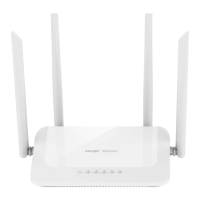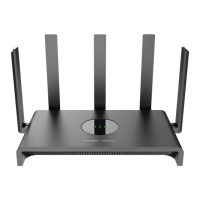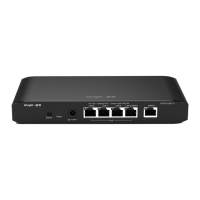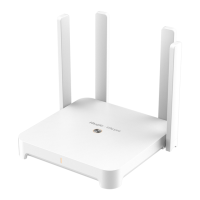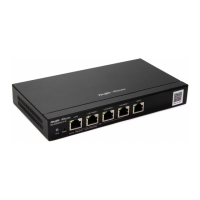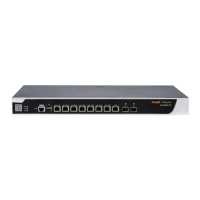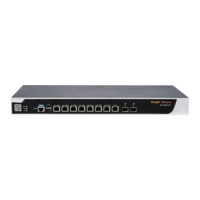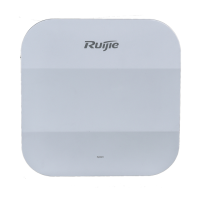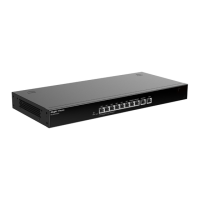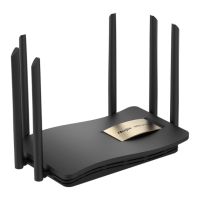
Do you have a question about the Ruijie Reyee RG-EW Series and is the answer not in the manual?
| Brand | Ruijie |
|---|---|
| Model | Reyee RG-EW Series |
| Category | Network Router |
| Language | English |
Explains the use of bold and italic fonts for GUI elements and commands.
Details the scenario and deployment requirements for eWeb management system configuration.
Introduces the Wizard page accessed without login for initial setup.
Explains the IP assignment process, recommending DHCP and detailing PPPoE options.
Guides on configuring SSID, Wi-Fi password, and management password.
Describes the final step of configuration delivery and entering the homepage.
Details the phone-based graphical user interface (GUI) for device management.
Describes the PC-based GUI, offering more configuration items than the phone-based version.
Provides an overview of the eWeb configuration interface, detailing device, WiFi, and interface information.
Explains how to view online clients connected to the device.
Covers fundamental configuration settings for the device.
Details WAN settings configuration, including IP assignment modes like DHCP and PPPoE.
Covers LAN settings, DHCP clients, static IP addresses, and DNS proxy.
Explains how to view and manage DHCP clients connected to the network.
Details how to add, delete, and edit static IP addresses for network management.
Describes the configuration of DNS proxy settings for network resolution.
Allows configuration of the device's operating mode, such as Router, Wired Repeater, or Wireless Repeater.
Covers wireless network configurations, including client management and settings.
Details how to view and manage wireless clients connected to the device.
Explains how to configure MAC address filtering for WiFi access, enabling blacklist or whitelist modes.
Allows configuration of primary WiFi settings, including SSID, password, and security.
Details configuring the primary WiFi network, including SSID, password, and security protocols.
Guides on enabling and configuring guest WiFi, including scheduling and isolation settings.
Allows enabling health mode for the WiFi and setting a schedule for its operation.
Covers advanced wireless settings like client count limit and channel width.
Provides functionality to group, upgrade, and delete Access Points (APs).
Covers security features including ARP list and MAC binding.
Displays ARP entries, showing IP-MAC mappings for connected devices.
Allows managing IP-MAC binding entries to enhance network security.
Manages network behavior through access control policies.
Allows adding, deleting, and editing access control policies based on MAC or IP addresses.
Enables adding, deleting, and editing time objects for scheduling purposes.
Covers advanced network configurations including flow control.
Allows configuration of smart flow control and custom flow control policies.
Enables adjustment of bandwidth allocation per user based on user count.
Details creating custom flow control policies for specific IP addresses or ranges.
Allows adding, deleting, and editing port mapping policies.
Enables adding, deleting, and editing NAT-DMZ rules for network address translation.
Allows enabling and viewing Universal Plug and Play (UPnP) settings.
Provides configuration for a local DNS server, defaulting to uplink device settings.
Offers tools for diagnosing network issues and checking device status.
Performs a comprehensive check of network connectivity and device status.
Provides network diagnostic tools like Ping, Traceroute, and DNS Lookup.
Enables packet capture for troubleshooting network issues.
Manages system-level settings including time and login.
Allows setting the system time, synchronizing with an NTP server or manual setting.
Manages login password and session timeout settings for the eWeb management system.
Guides on changing the device's login password, requiring re-login.
Sets the session timeout period for logging into the eWeb management system.
Covers configuration management tasks like backup, import, and restore.
Allows importing configuration files and exporting settings for backup.
Explains how to restore the device to its factory settings.
Allows rebooting or resetting devices, with caution advised due to network impact.
Enables control over the LED status for all equipment.
Covers both online and local upgrade procedures for device firmware.
Details downloading and applying firmware upgrades directly from the network.
Explains upgrading the device using a local firmware package file.
Allows performing an immediate reboot of the device.
Enables scheduling a device reboot for a specific time.
